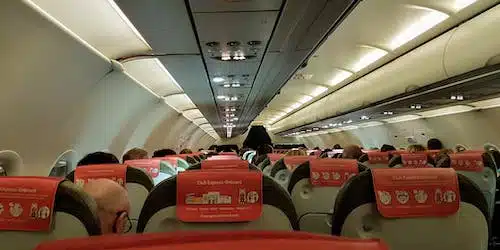Securing the best seat on a plane can significantly enhance your travel experience, whether it’s for added comfort, stunning views, or quicker access to the aisle. The best seat on a plane depends on personal preferences and the aircraft being flown. Some airlines charge a seat selection fee for non-last-row economy seats. Choose seats towards the front of the plane for quieter areas and faster access. Seats near engines or galleys may not be quieter.
Best Seat On A Plane
The best seat on a plane depends on personal preferences and needs, as well as the specific aircraft being flown. Nevertheless, it is vital to be aware that some airlines charge a seat selection fee to choose a spot that’s not in the last few rows of the cabin.
General Tips To Help You Choose The Best Seat On A Plane
#1. Avoid The Last Row Of Economy Seats
These seats usually don’t recline and are located right in front of the lavatories, which can be noisy and crowded.
#2. Choose A Seat Towards The Front Of The Plane
This area is usually quieter, and you can get on and off faster. If you have a tight connection, a seat closest to the front exit would be best.
#3. Consider Seats With Extra Legroom
Depending on the airline and airplane configuration, bulkhead seats and exit row seats have more legroom than other seats. However, be aware that not all exit row seats recline.
#4. Window Seats
If you want to sleep, a window seat would be best as you can lean against the window. If you want to minimize the effects of turbulence, a window seat above the wings is a good choice.
#5. Aisle Seats
If you like to get up and stretch, an aisle seat would be best. If you are a passenger of size, an aisle seat would be more comfortable.
#6. Avoid Seats In Front Of A Bulkhead
These seats often have limited or no recline.
#7. Smooth Ride
If you prioritize a smooth ride, consider choosing a seat over the wing. These seats tend to experience less turbulence compared to seats located at the front or back of the plane.
#8. Sleeping Comfort
If you plan on sleeping during the flight, a window seat near the front of the plane is often recommended. These seats provide a quieter and more secluded environment, allowing for better rest.
#9. Quick Plane Exit
If you want to be among the first to disembark the plane, choose a seat close to the front, preferably on the left side for dual-aisle aircraft.
#10. Specific Needs
Different passengers may have specific needs or preferences when it comes to choosing a seat. For example, if you are traveling with kids, a bulkhead seat with the kids by the window may be ideal. Passengers who require AC power may find middle seats more convenient. Larger passengers may prefer aisle seats for more comfort.
How To Choose The Best Seat On A Plane
Choosing the best seat on a plane can greatly enhance your comfort and overall travel experience. These factors can help to choose the best seat on a plane. Which includes
#1. SeatGuru and Seat Maps
Utilize resources like SeatGuru and airline seat maps to get detailed information about specific seats on your flight. These tools provide insights into seat dimensions, legroom, proximity to amenities, and passenger reviews.
#2. Window or Aisle
Decide whether you prefer a window seat for a view and a place to rest your head or an aisle seat for easier access to the aisle, especially if you anticipate needing to get up frequently during the flight.
#3. Legroom and Seat Pitch
Consider the seat pitch (distance between seats) and legroom offered by different seats. Seats with more legroom, such as exit row seats or bulkhead seats, can provide added comfort, especially on long-haul flights.
#4. Noise Level
Seats near the engines or galleys may be noisier, while seats towards the front of the plane tend to be quieter. Consider your preference for a quieter or more peaceful environment during the flight.
#5. Seat Selection Fees
Some airlines charge fees for seat selection, especially for preferred seats. Consider the cost and benefits before making a selection. Check the airline’s website or manage your booking online to see if seat selection is free or if fees apply.
#6. Flight Duration
The length of your flight can influence seat preferences. For longer flights, you may prioritize seats with more legroom or the ability to recline for added comfort. Shorter flights may not require as much consideration for seat selection.
#7. Seat Positioning
Some seats may be positioned slightly off-center or have misaligned windows, which can affect your view or overall comfort. Checking seat maps or reviews can help you avoid any potential issues.
#8. Seat Configuration
Pay attention to the seat configuration of the aircraft. Some planes have a 2-3-2 or 2-4-2 layout in economy class, which means that seats in the middle section may have more neighbors and less easy access to the aisle. Opting for seats on the side can provide more convenience.
#9. Consider Seat Selection Timing
If your airline allows seat selection during the booking process, try to select your seat as early as possible. This increases the likelihood of securing preferred seats before other passengers do. Some airlines also offer seat selection for free during check-in, so it’s worth checking if that applies to your flight.
#10. Ask for a Seat Change
If you are not satisfied with your assigned seat, politely inquire with the airline staff at the gate or during check-in if any alternative seats are available. They may be able to assist you in finding a better seat.
Benefits of Choosing The Best Seat On A Plane
Choosing the best seat on a plane can offer several benefits that can enhance your overall flight experience. The advantages of selecting the best seat include
#1. Comfort
Opting for a seat that provides more legroom, such as an exit row seat or a seat in front of the plane, can significantly increase your comfort during the flight. Having extra space to stretch your legs can make a long journey more enjoyable.
#2. Convenience
Seats near the front of the plane or close to the exit rows allow for quicker boarding and disembarkation. This can be particularly beneficial if you have a tight connection or want to be among the first to leave the aircraft upon arrival.
#3. Aisle or Window Preference
Choosing between an aisle or window seat depends on personal preference. Aisle seats offer easier access to the restroom and allow you to stretch your legs into the aisle. Window seats provide a view and a sense of privacy, as well as a spot to lean against for sleeping.
#4. Quiet and Peaceful Environment
Seats located towards the front of the plane or in quieter sections can offer a more peaceful atmosphere, reducing noise from engines and high-traffic areas. This can be advantageous if you want to rest or work without distractions.
#5. Armrest Advantage
Selecting a middle seat can sometimes provide a moral advantage when it comes to armrests. The person in the middle seat may have both aisle and window passengers contending for the armrest, allowing them to claim it for themselves.
#6. Better View
If you enjoy looking out of the window and taking in the scenery during your flight, choosing a window seat can provide you with a better view. This is especially true if you’re flying over picturesque landscapes or during takeoff and landing.
#7. Easy Access to Facilities
Selecting a seat near the restroom can be advantageous if you anticipate needing to use the facilities frequently. This can save you from having to navigate through a crowded cabin or wait in line.
#8. Avoiding Uncomfortable Situations
If you’re a light sleeper or prefer not to be disturbed during the flight, choosing a seat away from areas where passengers tend to congregate, such as near the galley or lavatories, can provide a quieter and more peaceful environment.
#9. Safety Considerations
Certain seats on the plane may offer added safety benefits. For instance, sitting in an exit row seat means you are closer to an emergency exit and may be able to assist in the event of an evacuation.
#10. Avoiding Motion Sickness
If you are prone to motion sickness, selecting a seat over the wings can help minimize the sensation of turbulence. These seats are closer to the plane’s center of gravity and tend to experience less movement during flight.
Drawbacks That Affect Having The Best Seat On A Plane
Avoiding the best seat on a plane can lead to various challenges and potential drawbacks. Which include
#1. Limited Legroom
If you don’t choose a seat with extra legroom, such as an exit row or bulkhead seat, you may have limited space to stretch your legs during the flight. This can lead to discomfort, especially on long journeys.
#2. Inconvenient Access
Opting for a seat that is not easily accessible, such as a middle seat or a seat located far from the aisle, can make it more challenging to move around the cabin, use the restroom, or access your belongings during the flight.
#3. Reduced Comfort
Seats located near high-traffic areas like galleys or lavatories can be noisy and disruptive, potentially affecting your comfort and ability to rest or work during the flight.
#4. Lack of Privacy
Not selecting a seat that offers more privacy, such as a window seat or a seat in a less crowded section of the plane, can result in a lack of personal space and privacy. This can be especially challenging if you want to relax, work, or have sensitive conversations during the flight.
#5. Discomfort during Turbulence
Seats located at the back of the plane tend to experience more turbulence compared to seats over the wings or at the front. If you don’t choose a seat that minimizes the impact of turbulence, you may experience more discomfort or motion sickness during the flight.
#6. Inconvenient Amenities
Some seats may offer additional amenities or features, such as extra storage space, power outlets, or in-flight entertainment screens. By not selecting a seat that provides these amenities, you may miss out on the convenience and comfort they offer.
#7. Limited Recline or Seat Width
Not choosing a seat with ample recline or sufficient seat width can result in discomfort, especially during long-haul flights. This can make it challenging to find a comfortable position for sleeping or relaxation.
#8. Limited Access to Overhead Bins
Seats located towards the back of the plane may have limited access to overhead bins, as they can fill up quickly during boarding. This can result in the need to store your carry-on luggage further away from your seat, potentially causing inconvenience during the flight.
#9. Separation from Travel Companions
If you’re traveling with family or friends and don’t select adjacent seats, you may be seated separately from your travel companions. This can be inconvenient, especially if you want to communicate or share the flight experience.
#10. Inability to Accommodate Specific Needs
If you have specific needs or preferences, such as requiring extra assistance, traveling with a pet, or needing additional space for medical equipment, not choosing an appropriate seat in advance may make it more challenging to accommodate those needs.
Is It Better To Sit In Front Or Back Of The Plane?
The decision of whether it’s better to sit in the front or back of the plane depends on individual preferences and priorities. Sitting in the front generally offers quieter surroundings, quicker boarding and disembarkation, and more legroom. However, seats towards the back may experience more turbulence and feel cramped. Factors such as noise, turbulence, comfort, service, and personal preferences should be considered when choosing a seat. It’s also helpful to consult seat maps and resources like SeatGuru for further information.
What Is the Best and Safest Seat On A Plane?
The back of the plane tends to have the lowest fatality rate in the event of a crash, making it statistically considered the safest area. The middle seats at the back of the plane had a fatality rate of 28%, while the aisle seats in the middle had a fatality rate of 44%. However, the overall safety of air travel is high, and the chances of being involved in an aircraft accident are extremely low. Airlines and experts emphasize that all seats on a plane are designed with safety in mind, and survival in a crash can depend on various factors specific to each incident. Nonetheless, the safest seat can vary depending on the circumstances of the crash.
Which Seat On A Plane Is Best For Turbulence?
The best seats on a plane to minimize the effects of turbulence are either over the wings or towards the front of the aircraft. The wings provide more stability and balance, resulting in a smoother ride. Sitting towards the front of the plane, especially in front of the wings, can also reduce the sensation of turbulence and provide a quieter flight experience. However, choosing a seat over the wings or towards the front can help minimize the effects of turbulence, but keep in mind that turbulence is a normal part of flying and is generally not a safety concern.
Which Seat Is Most Stable In A Plane?
The most stable seats on a plane are those located over the wings. These seats are closer to the center of mass and the more stable part of the aircraft, resulting in a smoother ride and a reduced sensation of turbulence. Also, sitting in rows 10 to 30, directly over the wings, is considered the best option for minimizing the effects of turbulence. Additionally, seats towards the front of the plane, especially in front of the wings, can also provide a more stable experience.
Where Should You Avoid Sitting On A Plane?
When selecting a seat on a plane, it is generally advised to avoid the back of the plane, middle seats, seats near bathrooms, seats with limited legroom, and seats with restricted views. Preferences may vary, and resources like SeatGuru can provide more information about specific aircraft and seat configurations.
What Are the Disadvantages of Sitting in the Back of the Plane?
Sitting in the back of the plane can have a few disadvantages. These include experiencing more turbulence, dealing with increased noise from auxiliary power units, potentially slower boarding and disembarkation times, and limited reclining in some seats. However, these disadvantages can vary depending on the specific aircraft and individual preferences.
Conclusion
Seats near the front, near the restroom, and away from congregating areas provide a peaceful atmosphere, while aisle seats offer easier access to restrooms and a better view. Avoiding the best seat on a plane can lead to challenges such as limited legroom, inconvenient access, reduced comfort, lack of privacy, discomfort during turbulence, inconvenient amenities, limited recline or seat width, and limited access to overhead bins. It’s crucial to choose a seat that offers the best balance of comfort, legroom, accessibility, privacy, and convenience for a comfortable flight.
- HOW EARLY CAN YOU CHECK FOR A FLIGHT? All You Need To Know
- WHAT ARE THE CHANCES OF GETTING A STANDBY FLIGHT?
- FIRST-TIME FLYING TIPS: 15 Best Tips
- WHAT IS STANDBY FLIGHT? All You Need To Know
- ECONOMY CLASS: Flights and Features






